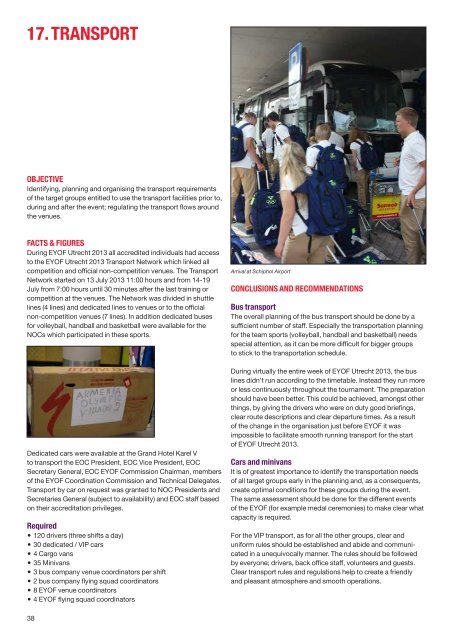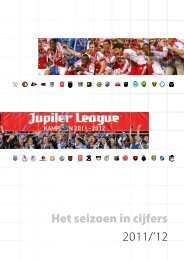eyof_final_report
eyof_final_report
eyof_final_report
You also want an ePaper? Increase the reach of your titles
YUMPU automatically turns print PDFs into web optimized ePapers that Google loves.
17. TRANSPORT<br />
18. ACCOMMODATIONS<br />
different hotels. A total of three Olympic Villages were used to<br />
accommodate the 3,150 athletes and officials from 13 to 20 July<br />
2013. Olympic Village I and II were situated in the east of Utrecht<br />
respectively 6.5 km and 5.5 km from Utrecht City Centre.<br />
Travel time between the two Villages was about five minutes<br />
(approximately three kilometres) by EYOF Utrecht 2013 shuttle<br />
bus. Olympic Village III was situated in the west of Utrecht and<br />
within walking distance from the Jaarbeurs and the Utrecht<br />
City Centre. Travel time to Olympic Village I and II was about<br />
20 minutes by the EYOF shuttle bus.<br />
OBJECTIVE<br />
Identifying, planning and organising the transport requirements<br />
of the target groups entitled to use the transport facilities prior to,<br />
during and after the event; regulating the transport flows around<br />
the venues.<br />
FACTS & FIGURES<br />
During EYOF Utrecht 2013 all accredited individuals had access<br />
to the EYOF Utrecht 2013 Transport Network which linked all<br />
competition and official non-competition venues. The Transport<br />
Network started on 13 July 2013 11:00 hours and from 14-19<br />
July from 7:00 hours until 30 minutes after the last training or<br />
competition at the venues. The Network was divided in shuttle<br />
lines (4 lines) and dedicated lines to venues or to the official<br />
non-competition venues (7 lines). In addition dedicated buses<br />
for volleyball, handball and basketball were available for the<br />
NOCs which participated in these sports.<br />
Arrival at Schiphol Airport<br />
AND RECOMMENDATIONS<br />
Bus transport<br />
The overall planning of the bus transport should be done by a<br />
sufficient number of staff. Especially the transportation planning<br />
for the team sports (volleyball, handball and basketball) needs<br />
special attention, as it can be more difficult for bigger groups<br />
to stick to the transportation schedule.<br />
OLYMPIC VILLAGES<br />
In the bid phase it had already been decided that the<br />
athletes would stay in student accommodation, divided over<br />
two Olympic Villages: Utrecht Science Park/De Uithof (Olympic<br />
Village I) and University College (Olympic Village II). At both<br />
locations short stay student accommodation and regular student<br />
accommodation was supposed to be used. In the end, the latter<br />
appeared not to be possible, which resulted in a capacity<br />
problem for approximately 500 people.<br />
In consultation with the EOC EYOF commission temporary<br />
accommodations were suggested as a sound solution, however<br />
in a later state, during the Chef de Mission seminar (end of April<br />
2013), it became clear that this solution was not suitable for the<br />
athletes. It was therefore decided to set up a third Olympic<br />
Village: the NH Hotel Utrecht. This meant that alternative hotel<br />
accommodation had to be found for referees, judges and key<br />
Festival Makers who had originally been booked at this hotel.<br />
This resulted in quite a few target groups being moved to<br />
OLV I<br />
In Olympic Village I approximately 1,000 athletes and officials<br />
were accommodated in student housing and were housed in<br />
1, 2 and 3-person rooms spread over three blocks. Apartments<br />
or multi-room units were used. Every apartment had its own<br />
bathroom with shower, toilet and washbasin and the ratio<br />
varied depending on the number of rooms and occupants per<br />
apartment. Most apartments and multi-room units had a ratio<br />
of one bathroom for every four participants. In some other<br />
cases ratio was one bathroom for every five or six occupants.<br />
The Campanna block rooms were too small for three athletes<br />
and therefore this facility was not ideal.<br />
NOCs housed at Olympic Village I had use of its own restaurant,<br />
NOC offices and First Aid station. The NOC Services Centre,<br />
Main Accreditation Centre and Sports Information Desks were<br />
also located in Olympic Village I. The Chefs de Mission meetings,<br />
most of the Technical meetings and the Medical meetings took<br />
place in Olympic Village I.<br />
OLV II<br />
In Olympic Village II, student housing accommodated approximately<br />
1,700 people in combination of 1, 2 and 3-person rooms.<br />
Apartments or multi-room units were used. Every apartment had<br />
its own bathroom with shower, toilet and washbasin and the ratio<br />
Dedicated cars were available at the Grand Hotel Karel V<br />
to transport the EOC President, EOC Vice President, EOC<br />
Secretary General, EOC EYOF Commission Chairman, members<br />
of the EYOF Coordination Commission and Technical Delegates.<br />
Transport by car on request was granted to NOC Presidents and<br />
Secretaries General (subject to availability) and EOC staff based<br />
on their accreditation privileges.<br />
CONCLUSIONS<br />
Required<br />
120 drivers (three shifts a day)<br />
30 dedicated / VIP cars<br />
4 Cargo vans<br />
35 Minivans<br />
3 bus company venue coordinators per shift<br />
2 bus company flying squad coordinators<br />
8 EYOF venue coordinators<br />
• 4 EYOF flying squad coordinators<br />
During virtually the entire week of EYOF Utrecht 2013, the bus<br />
lines didn’t run according to the timetable. Instead they run more<br />
or less continuously throughout the tournament. The preparation<br />
should have been better. This could be achieved, amongst other<br />
things, by giving the drivers who were on duty good briefings,<br />
clear route descriptions and clear departure times. As a result<br />
of the change in the organisation just before EYOF it was<br />
impossible to facilitate smooth running transport for the start<br />
of EYOF Utrecht 2013.<br />
Cars and minivans<br />
It is of greatest importance to identify the transportation needs<br />
of all target groups early in the planning and, as a consequents,<br />
create optimal conditions for these groups during the event.<br />
The same assessment should be done for the different events<br />
of the EYOF (for example medal ceremonies) to make clear what<br />
capacity is required.<br />
For the VIP transport, as for all the other groups, clear and<br />
uniform rules should be established and abide and communicated<br />
in a unequivocally manner. The rules should be followed<br />
by everyone; drivers, back office staff, volunteers and guests.<br />
Clear transport rules and regulations help to create a friendly<br />
and pleasant atmosphere and smooth operations.<br />
OLV I<br />
38 39



